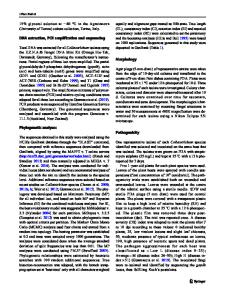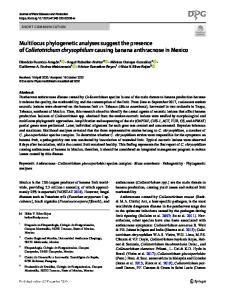First report of Colletotrichum fructicola causing anthracnose on Crinum asiaticum in Guangxi province, China
- PDF / 126,822 Bytes
- 1 Pages / 595.276 x 790.866 pts Page_size
- 78 Downloads / 304 Views
DISEASE NOTE
First report of Colletotrichum fructicola causing anthracnose on Crinum asiaticum in Guangxi province, China Zhen Qing 1 & Dan Xiao 1 & Haiyun Chen 1 & Yanan Shen 1 & Limei Pan 2 & Ronghui Wen 1 Received: 22 October 2019 / Accepted: 29 February 2020 # Società Italiana di Patologia Vegetale (S.I.Pa.V.) 2020
Keywords Anthracnose . Crinum asiaticum . Sequence analysis
Crinum asiaticum (family Amaryllidaceae) is an ornamental medicinal plant grown in gardens in tropical and subtropical countries. In September 2018, red spots and irregular lightbrown necrotic lesions were observed on C. asiaticum plants with an approximated incidence of 32% in the Nanning Botanical Garden of Medicinal Plants, Guangxi Province, China. The ornamental and medicinal value of C. asiaticum was significantly affected. The causal agent was isolated from small pieces of the symptomatic disinfested leaf by culturing on potato dextrose agar. Colonies went from white to gray with age, occasionally producing orange conidial masses. Conidia were 15.76 ± 1.4 μm × 6.10 ± 1.1 μm, hyaline, unicellular, and cylindrical. Using the method of Multilocus Sequence Analysis, identification was confirmed by amplification and sequencing of five DNA regions corresponding to the internal transcribed spacer (ITS), actin (ACT), β-tubulin (TUB2), chitin (CHS-1), and glyceraldehyde 3-phosphate dehydrogenase (GAPDH) (Damm et al. 2012). The sequences had high similarity with Colletotrichum fructicola accessions: ACT 100% with KR262555.1, ITS 99.8% with MF153385.1, GAPDH 99.6% with MH463893.1, CHS-1 99.6% with MN075573.1 and TUB2 99% with MF111053.1, respectively. Sequences were deposited in the GenBank with accession numbers MK935145 (ITS), MK922605 (ACT), MK922607 (TUB2), MK922608 (CHS-1), and MK922606 (GAPDH). To verify pathogenicity, spore suspensions (105 conidia/ml) were prepared from 12-day-old PDA cultures and then inoculated into 2-month-old C. asiaticum plants using the wound inoculation
* Ronghui Wen [email protected] 1
State Key Laboratory for Conservation and Utilization of Subtropical Agro-bioresources, College of Life Science and Technology, Guangxi University, Nanning, China
2
Guangxi Botanical Garden of Medicinal Plants, Nanning, China
method (Xu and Ko 1998). Control plants were established using sterile water during the inoculation process. All plants were placed in a growth chamber with a temperature of 26 °C. After five days, anthracnose symptoms identical to those observed in the field, developed on the inoculated leaves, and no symptoms on the control leaves. A fungus with the same colony and conidial morphology as C. fructicola was reisolated from leaf lesions on the inoculated leaves, thus confirming Koch’s postulate. C. fructicola has already been reported on C. asiaticum in Yunnan province, China (Yang et al. 2009), however, to our knowledge, this is the first report of anthracnose caused by C. fructicola on C. asiaticum in Guangxi province, China.
References Damm U, Cannon PF, Woudenberg JH, Crous PW (2012) The Colletotrich
Data Loading...











